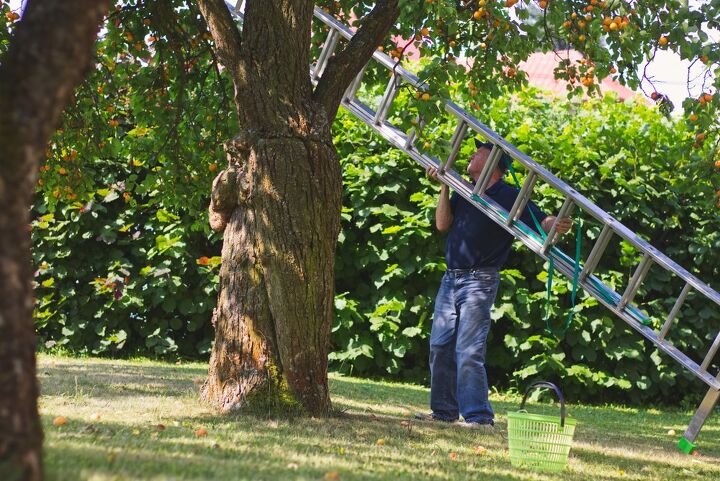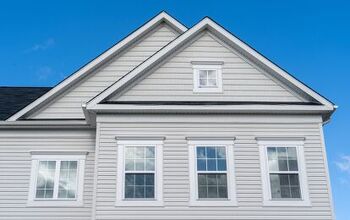Aluminum Vs. Fiberglass Ladder: Which Is Better?

Choosing the right ladder is not only a matter of quality but a matter of safety as well. Between aluminum and fiberglass ladders, there are hundreds upon hundreds of options ranging in quality and function. However, which one do you choose? How can you tell which one is better between aluminum ladders and fiberglass ladders?
Fiberglass ladders are better than aluminum ladders in that they stronger than aluminum, resistant to electricity, and last many years. Though, aluminum ladders are good as well and can certainly last a long time, but they are more likely to bend over time.
Let’s get into what makes aluminum and fiberglass different and why one is better than the other. This guide will take you through the ins and outs of each ladder and describing the pros and cons of each. That way, you can choose which one is the best fit for you.
Overview of Aluminum Ladders
Aluminum ladders are, of course, almost primarily made of aluminum, which is a ductile metal. This means that if it’s not constructed out of high-grade aluminum, the ladder will be able to bend easily. Heat can also negatively impact aluminum, causing it to lose its durability. Though, aluminum ladders are resistant to corrosion and work well for applications where moisture or water are a concern.
That said, let’s take a deeper look at some of the most prevalent advantages and disadvantages associated with aluminum ladders.
Ease of Use
When it comes to ease of use, aluminum ladders take the prize since they are lightweight. This is an important consideration, as ladders are large items. Aluminum ladders are easy to carry and move around as needed while doing the work you need to do.
Some can even weigh less than 20 pounds. This is a fantastic selling point when you need to move your ladder from room to room or transport it between job sites often. While the lightweight nature of aluminum ladders is a huge advantage, the tradeoff may be weaker than fiberglass.
Susceptible To Electricity
The main disadvantage of aluminum ladders is their susceptibility to the elements and electricity. Extreme heat and moisture can cause damage or bending for aluminum ladders that is not a problem with fiberglass alternatives.
Safety Measures And Size
Although aluminum ladders are sensitive to electrical conduction as they are metal, there are newer safety measures in place. Now, many aluminum ladders have rubber stand-offs that help prevents potential electrical shock or damage. You can find aluminum ladders in a wide range of sizes so that you are not limited in your options, whether it be a 10, 16, or 24 foot.
Low Lifespan
Besides that, aluminum ladders simply do not have as long of a life as fiberglass ladders, mostly due to how they are affected by heat. Because aluminum is a light metal, it does not hold up to damage as well as fiberglass and can bend somewhat easily.
Overview of Fiberglass Ladders
Unlike aluminum, which is present in the Earth’s crust, fiberglass is manmade. The material gets its strength from glass fibers, hence the name. These glass fibers give fiberglass ladders their rigid structure and durability. With proper care, fiberglass ladders can last you for more many years. They can be used in a wide variety of temperatures, climates, and weather elements, with little risk of degradation.
As such, fiberglass ladders are commonly used in professional and commercial settings. That said, let’s take a more comprehensive look at the most noteworthy advantages and disadvantages associated with fiberglass ladders.
Weather Resistant
Exposure to the elements does not affect fiberglass ladders in the way that it does to aluminum. You won’t expect a fiberglass ladder to lose strength from exposure to extreme heat, humidity, or rain. Because fiberglass is not a metal, there is no chance of shock or rusting. Considering that fiberglass lasts longer as elemental exposure does not affect them, the small additional cost is well worth it.
Fiberglass Ladders Are Heavy
Because fiberglass ladders are more massive than aluminum ladders, they can be hard to manage alone. That is the reason that many people doing a solo project use aluminum over fiberglass. With that said, the sturdiness and safety of fiberglass make it a better choice than aluminum.
Safety
One of the major advantages that fiberglass ladders have over aluminum ladders is that they are non-conductive and non-magnetic. This means that a fiberglass ladder is a safer choice for those performing electrical work. Though, there are some variations with some aluminum to reduce the weight and improve the ease of use. The most important factor is that the ladder is both steady and stable.
Higher Maximum Weight
The maximum load capacity is also often higher with fiberglass ladders. For example, a 20-foot aluminum often holds up to 250 pounds or more, whereas most aluminum 20-foot ladders have 300 pounds.
Aluminum vs. Fiberglass Ladder: Which One Should You Choose?
Fiberglass ladders are the best choice unless you are not physically able to maneuver it on your own. Whether it be a step or extension fiberglass ladder, they are a better choice mostly because they are cost-effective.
Between the two of them, aluminum ladders are lighter and easier to manage, but fiberglass ladders are typically much sturdier. For one-person jobs, aluminum ladders are great because they are light, but fiberglass ladders are a better choice.
The only scenario where aluminum would be the better choice is if you are looking for a small, light step ladder. Aluminum ladders are suitable for little things around the house, like hanging lights or painting, as long as electrical exposure is not an issue. With that said, if you are in immediate need of a ladder, aluminum is an excellent option as they are at any hardware store. The same can be said if heat and humidity is not an issue where you live.
Generally, however, fiberglass is the way to go because it will last you for years to come, and you won’t risk shock. They may be heavier than aluminum ladders, but fiberglass ladders make up for it in durability and longevity.
Cost Comparison
Whether a ladder is made of aluminum or fiberglass, the pricing is always based on the height. Typically, however, fiberglass ladders are slightly more expensive than aluminum. Fiberglass more than makes up for the increased cost with its longevity, durability, and safety.
Sure, fiberglass ladders can be more costly than aluminum ladders, but it is not a huge price difference. You typically wouldn’t have to pay much more than an additional $20 to $50 for a fiberglass ladder over an aluminum ladder.
Which Ladder is Best For Which Job?
Aluminum ladders are best for small, solo projects and fiberglass ladders are better for larger projects with more people involved. That is because aluminum ladders are easy to manage single-handedly when compared to fiberglass. However, if the job in question consists of any sort of exposure to electrical lines, then fiberglass is the better choice. There are aluminum ladders that have rubber stand-offs to help absorb electricity, but they are not as sure of a bet as fiberglass ladders.
If you are just doing some painting inside or outside, aluminum ladders are a good option. With that said, longer painting or similar jobs could benefit from fiberglass ladders. That is because they are more durable, and you don’t need to worry about bending.
Outside Jobs
When doing work outside, fiberglass ladders are the best option unless it is a quick job. With quick jobs like putting up lights, for example, heat exposure should not damage an aluminum ladder, which would be a good choice.
For longer outdoor jobs and chores, however, fiberglass is the way to go. The sturdiness and construction of fiberglass ladders allow you to stay in the sun for a long time without the heat damaging it. It is worth noting that aluminum ladders become quite hot to touch in the sun, which is less of an issue with fiberglass.
Ladder Safety Precautions
There’s one primary rule if you decide to use a lean-against ladder, which is called a 4 to 1 rule. For every 4 feet of height where the ladder rests against the structure, the base of the ladder should be 1 foot away. So, if you’re 24 feet up, the base of the ladder should be at least 6 feet away from the building.
Additionally, if you’re going to be using both hands while on the ladder, it’s a good idea to have someone with you in case of an accident. Some people even have a crash mat in case they fall.
Additional Tips
- Don’t use a ladder during storms
- Wear non-slip shoes
- Use at least one hand or a safety harness
- Don’t apply more weight to the ladder than the weight limit
What Did We Learn?
Fiberglass ladders are a better option when compared to aluminum. There are many advantages to fiberglass over aluminum ladders, such as:
- Sturdiness
- Heat resistance
- Electrically insulated
- Long-lasting
- Cost-effective
The only situation that choosing aluminum would be the right choice is to be limited physically and need something lighter. Ultimately, however, it is also a matter of personal taste. If you don’t need to worry about heat exposure, humidity, and electrical exposure, aluminum ladders would be a good choice. However, if you want a safe ladder that will last longer and not lose quality due to heat, fiberglass is a clear choice.
Essentially, fiberglass ladders are your safest bet to use both indoors and outdoors. If fiberglass is too heavy for you and you prefer aluminum, be sure to look for a ladder with rubber stand-offs. Otherwise, consider heading to the hardware store and investing in a fiberglass ladder that will last you years to come.

We are a team of passionate homeowners, home improvement pros, and DIY enthusiasts who enjoy sharing home improvement, housekeeping, decorating, and more with other homeowners! Whether you're looking for a step-by-step guide on fixing an appliance or the cost of installing a fence, we've here to help.
More by Upgraded Home Team














![The 5 Best Angle Grinders – [2022 Reviews & Buyer's Guide]](https://cdn-fastly.upgradedhome.com/media/2023/07/31/9071326/the-5-best-angle-grinders-2022-reviews-buyer-s-guide.jpg?size=350x220)








![Standard Dining Room Table Dimensions [for 4, 6, 8, 10 and 12 People]](https://cdn-fastly.upgradedhome.com/media/2023/07/31/9074335/standard-dining-room-table-dimensions-for-4-6-8-10-and-12-people.jpg?size=350x220)



